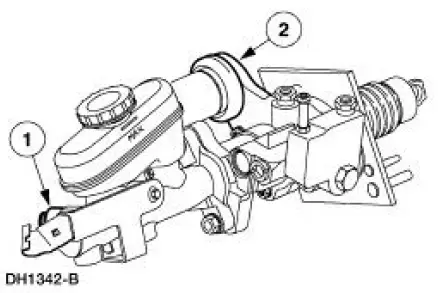Ford Mustang (1999-2004) Service Manual: Brake Booster - Hydro-Boost (Description and Operation)
The Hydro-Boost brake booster is a hydraulically operated brake booster powered by the power steering pump (3A674). The power steering pump provides the fluid pressure to operate both the power brake booster and the power steering gear (3504).
A Hydro-Boost reserve system (accumulator) stores sufficient fluid under pressure to provide at least two power-assisted brake applications in the event the power steering pump fluid flow is interrupted.
For low assist concerns on vehicles equipped with the Hydro-Boost system, refer to Section to check the power steering pump pressure and flow.


The brakes can also be applied manually if the reserve system is depleted.
Any leakage goes directly back to the power steering pump reservoir (3E764).
 Brake Booster - Vacuum (Description and Operation)
Brake Booster - Vacuum (Description and Operation)
Power Brake Booster
The vacuum type power brake booster (2005):
is a dual diaphragm, vacuum assisted power brake booster
reduces brake pedal force and travel distance.
is located on ...
 Hydro-Boost Bleeding
Hydro-Boost Bleeding
1. NOTE: The Hydro-Boost power brake booster (2B560) is generally
self-bleeding, and the
following procedure will normally bleed the air from the power brake booster.
Normal operation
of the vehicle ...
Other materials:
Torque Converter Diagnosis
Prior to the installation of a new or remanufactured torque
converter, all diagnostic procedures must be
followed. This is to prevent the unnecessary installation of torque
converters. Only after a complete
diagnostic evaluation can the decision be m ...
Vehicle identification number
The vehicle identification number
is located on the driver’s side
instrument panel.
Please note that in the graphic,
XXXX is representative of your
vehicle identification number.
The Vehicle Identification Number (VIN) contains the following
information:
...
Refueling
WARNING: Fuel vapor burns violently and a fuel fire can cause
severe injuries. To help avoid injuries to you and others:
• Read and follow all the instructions on the pump island.
• Turn off your engine when you are refueling.
• Do not smoke if you are n ...
